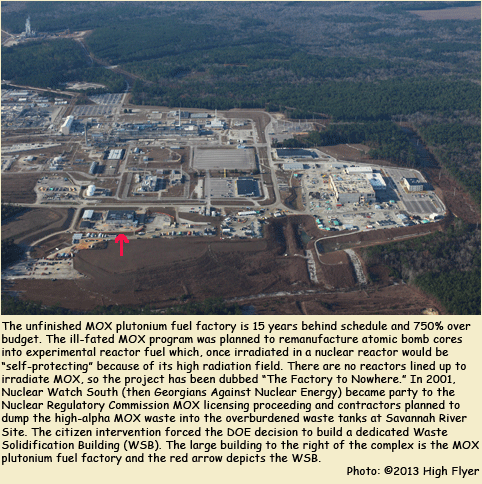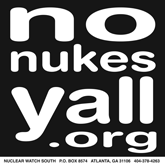

FUKUSHIMA NEWS
~ ~ ~ ~ ~ ~ ~
Help the
NO NUKES Y'ALL
campaign
y'all
Nuclear Watch South is a 501(c)(3) tax-deductible charitable organization.
{ thanks }
PayPal
It's your
safe and secure
way to donate on-line
 |
~ ~ ~ ~ ~ ~ ~

Educating and activating the grassroots to create a
nuclear-free future
~
PO Box 8574
Atlanta, GA 31106
404-378-4263
Cell 404-432-8727
info@nonukesyall.org
NO NUKES Y'ALL!
PLUTONIUM | MOX WASTE SOLIDIFICATION BUILDING
MOX Plutonium Waste Solidification Building to be Mothballed by NNSA
by Tom Clements, SC Sierra Club Adviser
COLUMBIA, SC 1/23/14 — Due to cost escalation and delays, a key facility to receive highly radioactive waste from the plutonium fuel (MOX) factory is to be mothballed prior to start-up, signaling more problems with the troubled MOX program.
 The MOX waste solidification building is key facility designed to receive radioactive nuclear waste from the $8-billion plutonium fuel (MOX) factory under construction at the Savannah River Site (SRS). It has been ordered to be placed in lay-up for at least five years by the Department of Energy (DOE), according to a government oversight panel. The problem-plagued Waste Solidification Building project will apparently be mothballed before the facility can be outfitted with equipment.
The MOX waste solidification building is key facility designed to receive radioactive nuclear waste from the $8-billion plutonium fuel (MOX) factory under construction at the Savannah River Site (SRS). It has been ordered to be placed in lay-up for at least five years by the Department of Energy (DOE), according to a government oversight panel. The problem-plagued Waste Solidification Building project will apparently be mothballed before the facility can be outfitted with equipment.
According to the Defense Nuclear Facilities Safety Board (DNFSB), the Waste Solidification Building (WSB), which has been plagued with cost overruns and schedule delays, will be placed in “lay-up” before all construction of the facility is completed and before installation of essential components.
The DNFSB, which has two staff members based at SRS, reported in the 12/27/13 weekly report on SRS that the DOE’s National Nuclear Security Administration (NNSA) would place the WSB on stand-by and that contractor Savannah River Nuclear Solutions (SRNS) has been so directed.
In light of the anticipated start-up date, NNSA issued direction to SRNS that the WSB will be placed in lay-up for a period of not less than five years following acceptance and startup testing of components and systems. Balance of plant construction is to be completed, but portable equipment not required for acceptance or startup testing, cementation glovebox windows, fiber optic cables, and capital spares will not be installed nor will additional equipment be purchased. The contractor is to develop the safety basis documents, submit them to NNSA, and maintain their configuration, but NNSA will not formally approve them during this lay-up period.
“The increased costs with the construction and operation of the facility to handle radioactive waste from the MOX plant are another red flag about just how far the MOX program has run off the budget rails,” said Tom Clements, adviser with the South Carolina Chapter of the Sierra Club. “While NNSA will predictably claim that they are shuttering the plutonium waste facility to save money it is actually being done for the opposite reason – that the overall MOX program is simply not financially sustainable."
The WSB has been designed, according to the DOE’s Fiscal Year 2014 budget request, “to process radioactive waste streams from the Mixed Oxide Fuel Fabrication Facility (MFFF) into the following waste forms: (1) a waste form that is suitable for shipment and disposal as transuranic waste at the Waste Isolation Pilot Plant, and (2) low-level waste (LLW) that is suitable for disposal at government or commercial LLW repositories. The WSB would provide a waste treatment capability not currently available at the Savannah River Site necessary to receive and treat unique waste streams generated by plutonium disposition.” (page DN-150)
As operation of the MOX fuel fabrication facility would depend on the receipt of radioactive plutonium and uranium waste by the Waste Solidification Building, a five-year halt to completion of the facility is an affirmation that the MOX plant itself would not be operational until 2019 or later (if it is completed, if can operate and if it has customers to take the MOX fuel). A 2019 or later start date for operation testing of the MOX plant could mean that commercial operation of all or part of the facility could not begin until multi-year MOX fuel testing was completed in unnamed nuclear reactors, a delay that would raise costs even further.
DOE informed Congress in the FY 2014 budget request about problems with the waste building and stated that “the WSB project incurred cost increases and schedule delays caused primarily by poor M&O management of subcontract execution and performance; early use of contingency for construction subcontract award; and design errors and omissions by M&O contractor.” Additionally, DOE stated in the budget request that “design errors, omissions, and inconsistencies” and that “subcontractor execution and performance have not met required targets,” resulting in higher costs and schedule delays. (pages DN-115,-148,-149)
The DOE’s Office of Acquisition and Project Management stated in a monthly update on DOE construction projects (in “Project Dashboard – December 2013”) that the original budget for the project was $344.5 million but that the current project budget had grown to $414.2 million. Costs are expected to go higher. Likewise, DOE stated in the FY2014 budget request that the operational cost of the project has jumped significantly and that it was expected to operate longer than earlier planned: “The previous estimate was that it would take fifteen years and cost $1,008,750 million for the facility to complete its mission, and this year that estimate has increased to $1,910,240 over twenty years.” (Page DN-148)
“An operational cost of $100 million per year just to manage MOX waste will add to the strain on the overall DOE budget for more than two decades and is another clear reason that cheaper, quicker and safer non-MOX plutonium disposition options must be immediately pursued,” according to Clements.
The Omnibus spending bill, signed into law on January 17, 2014, requires a study on the reasons for cost increases with both the Waste Solidification Building and the MOX project: “The Department of Energy is directed to undertake a root cause analysis that identifies the underlying causes of the cost increases for the MOX and Waste Solidification Building projects and that includes the identification and prioritization of recommended solutions and corrective measures.”
In keeping with unjustified and on-going secrecy designed to keep news from the public about the troubled MOX program, NNSA has not publicly commented about the mothballing of the MOX waste building.
Notes:
1. Defense Nuclear Facilities Safety Board (DNFSB) weekly report for Savannah River Site, 12/27/13
2. DOE Fiscal Year 2014 budget request to Congress, Vol. 1 (National Nuclear Security Administration)
3. DOE’s Office of Acquisition and Project Management “Project Dashboard – December 2013”
4. Consolidated Appropriations Act, 2014 - DIVISION D--ENERGY AND WATER DEVELOPMENT AND RELATED AGENCIES APPROPRIATIONS ACT, 2014 EXPLANATORY STATEMENT
page 37 (page 73 in PDF):
"Mixed Oxide (MOX) Fuel Fabrication Facility.-The agreement provides $343,500,000. [$320 million requested] The Department of Energy is directed to undertake a root cause analysis that identifies the underlying causes of the cost increases for the MOX and Waste Solidification Building projects and that includes the identification and prioritization of recommended solutions and corrective measures. The Department shall submit a report on the results of its analysis to the Committees on Appropriations of the House of Representatives and the Senate not later than 180 days after enactment of this Act."
"To the village square
we must carry the facts
of atomic energy.
From there must come America's voice."
ALBERT EINSTEIN
~~~~~~

~~~~~~
NY Times on MOX
U.S. Moves to Abandon Costly Reactor Fuel Plant
by Matt Wald
6/25/13
~~~~~~
MOX EXPOSED TO
CYBER ATTACKS
by Derreck Asberry
Aiken Standard
NRC PANEL REVIEWS FEARS PLUTONIUM VULNERABLE TO THEFT
by Douglas P. Guarino
NTI
INTERVENORS' RESPONSE
TO SHAW AREVA MOX SERVICES
April 19, 2013
~~~~~~
HOT MOX NEWS!
In-depth look at MOX plutonium fuel boondoggle from Center for Public Integrity
by Douglas Birch and
R. Jeffrey Smith
Nuclear Waste:
How a huge U.S. nonproliferation program became a major proliferation concern
6/24/13
Nuclear Waste:
A $1 billion Energy Department project overshoots its budget by 600 percent
6/25/13
Nuclear Waste: Extremism in defense of federally-paid jobs is no vice in South Carolina
6/26/13
Nuclear Waste: Washington has ignored a cheaper way to dispose of its plutonium — until now
6/27/13
~~~~~~
NRC BLOG
3/15/12
It's Time to Pull the
Plug on the MOX "Factory to Nowhere"
by Ed Lyman
~~~~~~
MOX ORDER
4/1/11
LICENSING BOARD ADMITS ADDITIONAL CONTENTIONS REGARDING
MIXED-OXIDE FUEL FABRICATION FACILITY LICENSE APPLICATION
NRC Press Release
4/1/11
~~~~~~
MORE ON MOX LEGAL INTERVENTION
NRC MOX LETTER
NRC MOX WEBSITE
NRC MOX LICENSING
MOX LICENSE APPLICATION
RED OIL REPORT
MOX PLAN HITS ROADBLOCK
NUCLEAR FUEL TEST FAILURE RAISES CONCERNS
~~~~~~
PLUTONIUM FACTS
Year plutonium was discovered by Glenn Seaborg and others
1941
Minimum amount of plutonium required for bomb
1 kilogram (2.2 pounds)
Amount of plutonium used in Nagasaki bomb
6.5 kilograms
Average amount of plutonium used in modern atom bomb
3 kilograms
Estimated amount of U.S. weapons-grade plutonium
85,000 kilograms (93.5 tons)
Estimated amount of Russian weapons-grade plutonium
160,000 kilograms (176 tons)
Hazards associated with plutonium
Radiation, fire, inhalation, ingestion, criticality, reactivity, decay
Length of time that
plutonium 239 (weapons-grade) remains hazardous
240,000 years
(Ten 24,000-year half-lives)
Form of plutonium most hazardous to life
Plutonium oxide powder
What happens to plutonium metal when exposed to air
Gradually turns to
plutonium oxide powder
Lethal amount of plutonium oxide powder (inhaled)
2000 micrograms
Lethal amount of plutonium oxide powder (ingested)
500,000 micrograms
Amount of sugar substitute in average 1 gram package
1,000,000 micrograms
Excerpted from Stop Plutonium Fuel: Plutonium Index, compiled by Don Moniak. Blue Ridge Environmental Defense League, www.bredl.org

